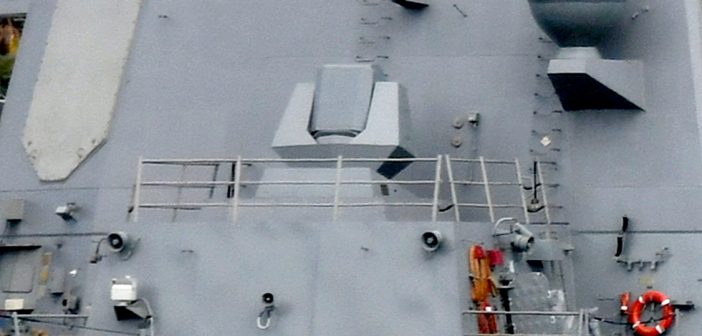By Christopher P. Cavas
SAN DIEGO – The waterfront in this Navy town is always bristling with warships carrying guns, missiles and powerful electronic systems. But a new feature appeared recently in the form of laser weapons mounted aboard two ships based here. And more lasers are coming.
The amphibious transport dock USS Portland (LPD 27) was fitted in the fall of 2019 with a new, 150-kilowatt weapon developed by the Office of Naval Research (ONR) and Northrop Grumman. The weapon, part of the Solid-State Laser Technology Maturation (SSL-TM) effort, is significantly more powerful than the 33 kW Laser Weapon System (LaWS) installed in 2014 aboard the now-decommissioned afloat forward staging base ship Ponce (AFSB 15).
The laser aboard Portland is installed forward in the ship in a trunk structure originally intended for a never-fitted vertical launch system. The LPD was selected because the ship had the space and weight capacity along with already-installed electrical cables to ease the laser installation.
The SSL-TM laser is in a trainable mounting with a clear field of fire forward and to about 65 degrees abaft each beam. No publicly available images of the weapon firing are yet known, although the system underwent testing last year on the White Sands Missile Range in New Mexico.
Portland has been underway since the weapon was installed and in mid-February took part in Exercise Iron Fist at Camp Pendleton, California, but testing of the laser is expected to begin later this year. According to the Naval Sea System’s (NAVSEA) Command LPD program office in late 2018, intentions are for the Portland to deploy with the weapon later in 2020 after tests are completed, but Navy officials declined to confirm to Defense and Aerospace Report whether that plan is still in place.
The 2020 test program for the SSL-TM system aboard Portland was discussed in the Pentagon’s Fiscal 2021 defense budget request sent to Congress on Feb. 10.
“At-sea testing and experimentation will be conducted with full laser weapon system demonstrator” during 2020, according to the budget documents. “During this period the technical performance will be evaluated in various atmospheric and sea state conductions while conducting operational missions and exercises. Lessons learned from operations and maintenance will be documented to inform development of future laser weapons systems development efforts.”
It is not yet clear if the laser will become a permanent feature aboard Portland.
While the Navy publicized the laser installation aboard Portland, a similar laser weapon was fitted in more secrecy aboard the destroyer USS Dewey (DDG 105), which appeared late last year with a different system installed during a shipyard overhaul.
Little official information was available about the Dewey’s system until Feb. 20, when NAVSEA issued a release describing the Dewey’s Optical Dazzling Interdictor, Navy (ODIN) system as “a laser weapon system that allows a ship to counter unmanned aerial systems.”
According to the release, the ODIN system was approved in early 2017 based on an urgent need requirement from US Pacific Command. It was developed by Naval Surface Warfare Dahlgren, Virginia and installed after two and half years. The system, NAVSEA said, “will be the first operational employment of the stand-alone system that functions as a dazzler. The system allows the Navy to rapidly deploy an important, new capability to the Navy’s surface force in combating Unmanned Aircraft Systems (UAS) threats.”
ODIN is the first operational deployment of a laser dazzler, a Navy official said, adding that the stand-alone system is equipped with a laser that can temporarily degrade intelligence-gathering capabilities of unmanned aerial systems.
Capt. Danny Hernandez, spokesman for the Navy’s acquisition directorate, noted that the laser cab “temporarily degrade intelligence-gathering capabilities of unmanned aerial systems,” but he did not provide more information about the ODIN system, including its power, lethality and future plans. He would also not discuss how many ships would have the ODIN system installed, but added, “there are number of other laser weapon systems of varying capabilities in rapid development that will provide increased lethality for the fleet.”
The NAVSEA release notes that, “within the next couple of years, the ODIN program will have all [ODIN] units operational within the fleet providing a safer and more technically advanced capability to the US Navy. Lessons learned from ODIN’s installation on Dewey will inform installation on future vessels and further development and implementation of Surface Navy Laser Weapon Systems.”
The ODIN system on Dewey is installed forward atop the unused Phalanx close-in weapons system (CIWS) foundation. CIWS was not fitted on Dewey and a number of other Flight IIA Arleigh Burke-class destroyers as the Evolved Sea Sparrow Missile (ESSM) was thought to be a more effective weapon for close-in defense. In the event, however, CIWS Mark 1B was developed with an enhanced counter surface-warfare capability and all destroyers completed without CIWS have had at least one installed in the after position.
ODIN is not the first laser system fitted to the Dewey. A prototype LaWS system was installed on the ship’s flight deck in 2012, but that system, also developed by ONR, was never intended to be permanent and was removed after tests.
Among other laser systems in the works for fitting aboard US Navy ships is the High Energy Laser and Integrated Optical Dazzler with Surveillance (HELIOS) directed energy system, under development by Lockheed Martin. Navy officials said in March 2019 that HELIOS would be fitted in fiscal 2021 on a West Coast-based Arleigh Burke Flight II-class destroyer.
Interestingly, the LaWS laser removed from the Ponce is being used as a land-based test asset for the HELIOS program, according to the Congressional Research Service (CRS).
HELIOS is described in budget documents as another dazzler but will have a lethal capability to destroy unmanned vehicles and cripple small attack craft. A CRS report in February identified the first destroyer to be fitted with HELIOS as the Preble (DDG 88), based in Pearl Harbor.
All photos copyright Christopher P. Cavas
Posted: 29 Feb 20 2000
Email at chriscavas@gmail.com



